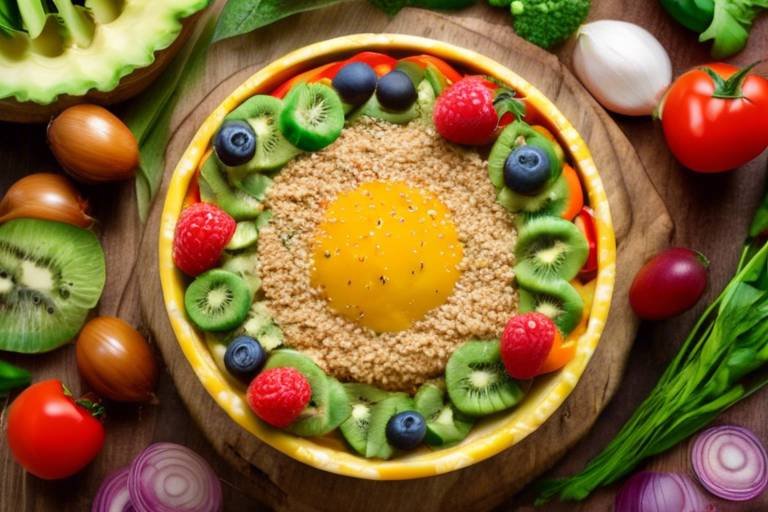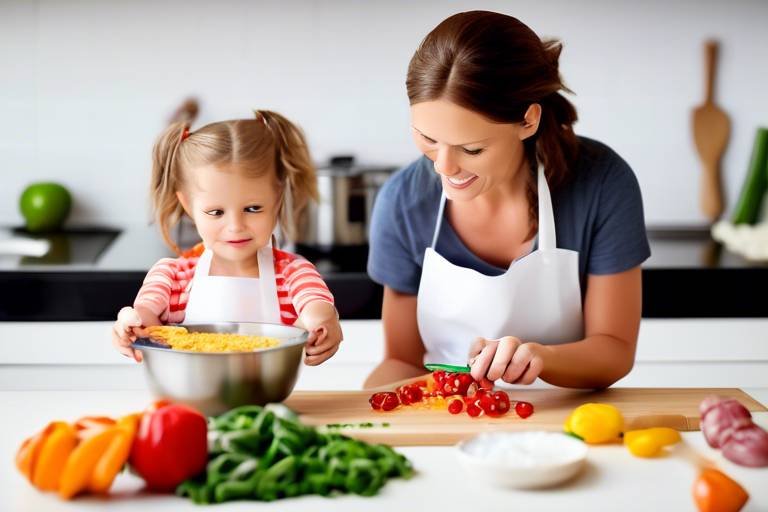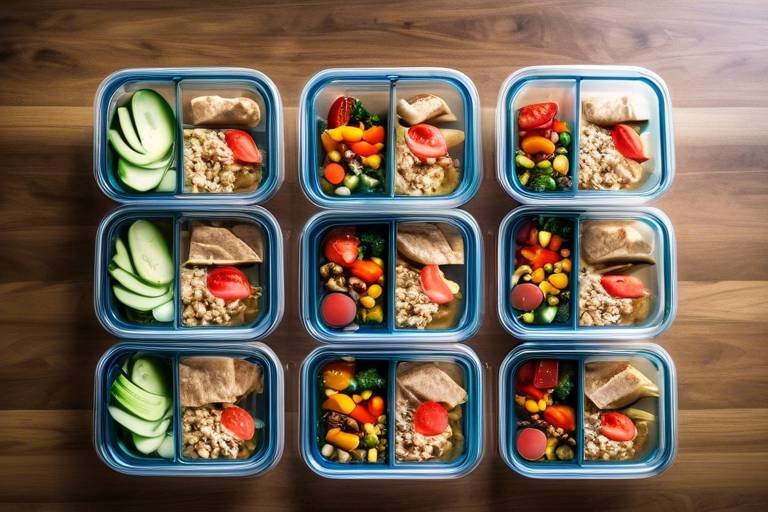The Benefits of Meal Planning for Busy Families
In today's fast-paced world, families often find themselves juggling various responsibilities, from work commitments to extracurricular activities. Amidst this whirlwind, meal planning emerges as a powerful tool that can transform the way families approach their meals. Imagine a scenario where you no longer need to scramble for dinner ideas at the last minute or waste precious time deciding what to eat. Instead, with a little foresight and organization, you can create a roadmap for your meals that not only saves time but also promotes healthier eating habits and helps you stick to your budget.
Meal planning is not just about deciding what’s for dinner; it’s about creating a system that works for your family. It allows you to strategically map out your meals for the week, ensuring that you have everything you need on hand. This can lead to a more harmonious household where everyone knows what to expect at mealtime, reducing stress and making it easier to gather around the table together. Whether you’re a busy parent, a student, or anyone in between, meal planning can be your secret weapon for conquering the chaos of daily life.
As you delve into the benefits of meal planning, you’ll discover that it’s not only about convenience but also about making smarter choices for your family’s health and well-being. In the sections that follow, we’ll explore how meal planning can enhance your time management, save you money, reduce food waste, and promote healthier eating habits. So, let’s get started on this journey towards a more organized and fulfilling family dining experience!
One of the primary advantages of meal planning is its ability to significantly enhance time management. When you take the time to plan your meals ahead of time, you can reduce the daily cooking time and the number of grocery shopping trips. Imagine coming home after a long day and knowing exactly what you’re going to prepare for dinner. No more last-minute takeout or frantic searches through the fridge! Instead, you can allocate your time more effectively, allowing your family to enjoy more quality moments together.
To effectively allocate time for meal preparation, consider setting aside a specific day each week to plan your meals. This could be a Sunday afternoon or any day that works best for your schedule. During this time, you can decide on recipes, create a shopping list, and even do some meal prep, such as chopping vegetables or marinating proteins. By doing so, you’ll streamline your weekdays, making them less hectic and more enjoyable.
Another compelling reason to embrace meal planning is the potential for cost savings. By planning meals in advance, families can minimize food waste and make smarter grocery purchases. Have you ever found a half-used ingredient lurking in the back of your fridge, only to toss it out weeks later? Meal planning helps you avoid these scenarios by ensuring that you utilize what you buy. This not only saves you money but also contributes to a more sustainable lifestyle.
Meal planning encourages families to utilize ingredients more efficiently, which is crucial in reducing food waste. When you plan your meals, you can create dishes that use similar ingredients, ensuring nothing goes to waste. For instance, if you buy a bunch of spinach, you can incorporate it into salads, omelets, and smoothies throughout the week. This approach not only saves money but also promotes sustainability by minimizing the amount of food that ends up in landfills.
Creating a shopping list based on your planned meals can prevent impulse buying and unnecessary purchases. When you have a clear list, you’re less likely to stray into the snack aisle or pick up items that don’t align with your meal plan. Consider organizing your shopping list by grocery store sections to make your shopping trip even more efficient. This way, you can quickly grab everything you need without wandering aimlessly through the store.
Incorporating leftovers into meal planning is a fantastic way to minimize waste and maximize resources. For example, if you roast a chicken for dinner, you can use the leftover meat in sandwiches, salads, or soups the next day. This not only saves time but also creates opportunities for delicious new meals that your family will love. Get creative with your leftovers and turn them into something exciting!
Meal planning also encourages healthier eating choices by allowing families to incorporate nutritious ingredients and create balanced meals. With a little planning, you can ensure that your family is getting a variety of food groups, including fruits, vegetables, whole grains, and lean proteins. This not only supports physical health but also fosters a positive relationship with food.
Engaging family members in the meal planning process fosters teamwork and ensures everyone’s preferences are considered. When everyone has a say in what’s on the menu, they are more likely to enjoy the meals and feel invested in the process. Consider hosting a family meeting each week where everyone can contribute ideas and vote on their favorite meals.
Cooking as a family can strengthen bonds and make mealtime more enjoyable. Involve your kids in the cooking process by assigning them age-appropriate tasks. Not only does this teach them valuable skills, but it also turns cooking into a fun, interactive activity that everyone can look forward to. Plus, who doesn’t love a little kitchen dance party while you’re chopping vegetables?
Involving children in meal planning can help them make healthier food choices and develop lifelong healthy eating habits. Use this opportunity to teach them about nutrition and the importance of balanced meals. You might be surprised at how eager they are to try new foods when they feel included in the decision-making process!
- How do I start meal planning? Begin by choosing a day to plan your meals for the week, then create a shopping list based on those meals.
- What if my family has different dietary needs? Customize your meal plan to include a variety of options that cater to everyone's preferences and requirements.
- How can I make meal planning easier? Use apps or templates to organize your meal plans and shopping lists, and consider meal prepping on weekends.

Time Management
In today's fast-paced world, time is a precious commodity, especially for busy families juggling work, school, and extracurricular activities. Meal planning can be a game-changer, significantly enhancing your time management skills. Imagine this: instead of scrambling to figure out what to cook for dinner every evening, you can spend just a couple of hours once a week to plan out your meals. This simple shift can transform your daily routine, allowing for more quality time with your loved ones.
When you have a meal plan in place, you can streamline your cooking process. For instance, you can batch cook meals on weekends, which means you’ll have ready-to-eat options throughout the week. This not only cuts down on daily cooking time but also reduces the stress of last-minute meal decisions. Think of it as creating a roadmap for your week—when you know where you're going, the journey becomes much smoother.
Additionally, meal planning allows you to allocate specific times for grocery shopping and meal prep. Instead of making frequent trips to the store, you can consolidate your shopping into one or two trips each week. This not only saves time but also minimizes the temptation to make impulse purchases. Here’s a quick breakdown of how meal planning can enhance your time management:
| Activity | Traditional Approach | Meal Planning Approach |
|---|---|---|
| Cooking | Daily cooking with no plan | Batch cooking on weekends |
| Grocery Shopping | Multiple trips throughout the week | One or two planned trips |
| Meal Decisions | Last-minute choices | Pre-planned meals |
By setting aside a little time each week for meal planning, you can create a structured approach to your meals. This not only helps in managing your time effectively but also contributes to a more organized household. Plus, it’s a fantastic way to involve the whole family in the process. You can sit down together, discuss the week ahead, and plan meals that everyone will enjoy. This not only makes meal times more exciting but also instills a sense of responsibility and teamwork among family members.
So, the next time you feel overwhelmed by the prospect of feeding your family, remember that with a little planning, you can turn chaos into order. Meal planning isn’t just about preparing food; it’s about reclaiming your time and enhancing your family life. Why not give it a try? You might be surprised at how much easier mealtime can become!
- How much time should I allocate for meal planning? Generally, 1-2 hours a week is sufficient to plan meals and create a shopping list.
- Can meal planning really save me money? Absolutely! By planning meals and shopping with a list, you can avoid impulse buys and reduce food waste.
- What if my family members have different dietary needs? Meal planning can be flexible! Consider planning meals that can be easily adapted to meet everyone's preferences.

Cost Savings
When it comes to managing a household, can be a game-changer, especially for busy families juggling multiple responsibilities. Meal planning is not just about organizing what to eat; it's a smart strategy that can lead to significant financial benefits. By planning meals in advance, families can minimize food waste, make more informed grocery purchases, and ultimately keep their budgets in check. Imagine walking into a grocery store with a clear plan instead of wandering the aisles aimlessly—this focused approach can save both time and money!
One of the primary ways meal planning leads to cost savings is by reducing food waste. When you plan meals, you're more likely to use ingredients efficiently, ensuring that nothing goes to waste. For instance, if you buy a bunch of spinach for a recipe, you can plan another meal that also uses spinach, thus preventing that fresh produce from wilting away in the fridge. This not only promotes sustainability but also means less money spent on groceries that end up in the trash. To illustrate this point, consider the following statistics:
| Food Waste Statistics | Potential Savings |
|---|---|
| Average family wastes $1,500 worth of food annually | By meal planning, families can save up to 25% of this waste |
| Weekly grocery trips without a plan | Increased impulse buys leading to additional $100/month |
Moreover, creating a smart shopping list based on your meal plan can significantly cut down on unnecessary purchases. When you have a clear list, it’s easier to stick to what you need, avoiding those tempting impulse buys that can quickly add up. This means you can allocate your budget more wisely, purchasing only what you need for planned meals. In fact, studies show that families who use shopping lists can save an average of 10-15% on their grocery bills.
Another effective strategy is to incorporate leftovers into your meal planning. Instead of viewing leftovers as a burden, think of them as a resource! For example, if you roast a chicken on Sunday, you can use the leftover meat for sandwiches, salads, or soups throughout the week. This not only saves money but also time spent cooking, as you’re repurposing what you’ve already prepared. Here are a few creative ideas for using leftovers:
- Turn roasted vegetables into a frittata.
- Use leftover rice in stir-fries or grain bowls.
- Transform last night’s pasta into a cold pasta salad for lunch.
In summary, meal planning is a powerful tool that can lead to substantial cost savings for busy families. By reducing food waste, creating smart shopping lists, and utilizing leftovers, families can stretch their grocery budget further while still enjoying delicious and nutritious meals. So, the next time you sit down to plan your weekly meals, remember that you’re not just organizing your dinners; you’re also making a smart financial decision!
Q: How much time does meal planning typically take?
A: Meal planning can take anywhere from 30 minutes to a couple of hours, depending on how detailed you want to be. However, the time invested can save you hours during the week!
Q: Can meal planning really help with a tight budget?
A: Absolutely! By planning meals and creating a shopping list, you can avoid impulse purchases and reduce food waste, leading to significant savings.
Q: What if my family has different dietary preferences?
A: Meal planning can be flexible! You can prepare base meals and customize them with different toppings or sides to accommodate everyone’s preferences.

Reducing Food Waste
Reducing food waste is not just a trend; it's a necessity for busy families looking to save money and promote sustainability. When you sit down to plan your meals, you’re not just deciding what's for dinner; you’re also making a conscious choice to use ingredients more efficiently. Think of meal planning as a puzzle where every piece matters. By carefully considering what you buy and how you’ll use it, you can create delicious meals while minimizing waste.
One of the best ways to tackle food waste is by utilizing what you already have in your pantry and fridge. Before you start planning your meals for the week, take a quick inventory of what’s on hand. Are there vegetables that are nearing their expiration date? Perhaps some grains or proteins that could be incorporated into your meals? By using these ingredients as the foundation of your meal plan, you not only reduce waste but also save money. It’s like a treasure hunt in your kitchen!
Another effective strategy is to create meals that share similar ingredients. For instance, if you buy a bunch of spinach, plan to use it in multiple dishes throughout the week. You could toss it into a salad, blend it into a smoothie, or sauté it with garlic as a side dish. This approach not only ensures that you’re using what you buy but also adds variety to your meals. Here’s a quick example of how you can plan meals around a single ingredient:
| Ingredient | Meal 1 | Meal 2 | Meal 3 |
|---|---|---|---|
| Spinach | Spinach Salad with Chicken | Spinach and Cheese Stuffed Shells | Spinach Smoothie |
Additionally, consider incorporating leftovers into your meal planning. Leftovers can be a goldmine if you know how to repurpose them creatively. For example, if you have roasted chicken from one night’s dinner, you can use the remaining meat for sandwiches, salads, or even a hearty soup the next day. It’s all about thinking ahead and being resourceful. By doing this, you’re not just saving money; you’re also teaching your family the value of not wasting food.
Lastly, it’s essential to store food properly to extend its shelf life. Many families toss out perfectly good food simply because it spoiled too quickly. Invest in good-quality storage containers, and learn the best practices for keeping fruits, vegetables, and leftovers fresh. For example, did you know that keeping apples in the fridge can help them last longer? Or that certain vegetables do better in a dry environment? Paying attention to storage can make a significant difference in how long your food lasts.
In conclusion, reducing food waste through meal planning is not only beneficial for your wallet but also for the planet. By being mindful of what you buy, how you store it, and how you use it, you can create a more sustainable kitchen. Remember, every little bit counts, and with a little creativity and planning, you can make a big impact on reducing food waste in your home.
- How can meal planning help reduce food waste? Meal planning allows you to use ingredients more efficiently and ensures that you buy only what you need, minimizing excess and spoilage.
- What are some effective ways to use leftovers? Get creative! Leftovers can be transformed into new meals, such as using roasted chicken in salads or soups.
- How can I store food to make it last longer? Proper storage is key. Use airtight containers, keep fruits and vegetables in the right environment, and understand which foods need refrigeration.

Smart Shopping Lists
Creating is a game-changer for busy families looking to streamline their grocery shopping experience. Think of your shopping list as your secret weapon against impulse buying and unnecessary purchases. When you have a clear plan in place, you not only save time but also money. So, how do you create an effective shopping list that aligns with your meal plan? Let’s dive in!
First and foremost, start by reviewing your meal plan. This is your blueprint for the week, so take a moment to jot down all the ingredients you’ll need for each meal. For example, if you’re planning to make a delicious stir-fry, you’ll want to list out all the veggies, proteins, and sauces required. By doing this, you’ll have a comprehensive understanding of what’s necessary, which helps in avoiding any last-minute dashes to the store.
Next, consider organizing your list by categories. This simple trick can save you a ton of time in the store. Group items by sections such as produce, dairy, meats, and pantry staples. Here’s a quick example of how to categorize your shopping list:
| Category | Items |
|---|---|
| Produce | Carrots, Bell Peppers, Broccoli |
| Dairy | Milk, Cheese, Yogurt |
| Meats | Chicken, Ground Beef, Fish |
| Pantry | Rice, Pasta, Canned Tomatoes |
This way, when you’re in the store, you can quickly grab everything you need without zigzagging through the aisles. Plus, it makes the shopping experience feel less overwhelming, especially when you’re juggling kids and a busy schedule.
Another tip is to check your pantry and fridge before heading out. You might already have some of the ingredients you need, which can help you avoid buying duplicates. This practice not only saves money but also ensures that you’re using what you already have, reducing food waste.
Lastly, consider using digital tools or apps to create your shopping list. Many apps allow you to share lists with family members, so everyone can contribute. Imagine your partner adding items while you're out, ensuring you never forget that crucial ingredient again! Plus, digital lists can be easily updated, making them incredibly convenient.
In summary, smart shopping lists are all about preparation and organization. By planning ahead, categorizing your items, and utilizing technology, you can transform your grocery shopping into a more efficient and enjoyable experience. This not only saves you time and money but also helps you stick to your meal plan, leading to healthier eating habits for your family.
- How do I start meal planning? Begin by choosing a day each week to plan your meals and create a shopping list based on those meals.
- What if my family has different dietary needs? Consider planning meals that can be easily customized or involve a variety of ingredients to accommodate everyone.
- How can I make meal planning easier? Use apps or templates to streamline the process, and involve family members to share the workload.

Using Leftovers Wisely
In today's fast-paced world, leftovers can often be seen as a burden rather than a blessing. However, when meal planning is done right, leftovers can transform into a culinary adventure, saving both time and money while reducing food waste. Imagine opening your fridge and seeing a treasure trove of ingredients just waiting to be repurposed into something delicious. By using leftovers thoughtfully, families can not only stretch their grocery budget but also enjoy a variety of meals throughout the week.
One of the most effective ways to use leftovers is by incorporating them into new dishes. For instance, if you have leftover roasted chicken, it can easily be transformed into a hearty chicken salad, a flavorful soup, or even a delicious stir-fry. The key is to think creatively and be open to experimenting in the kitchen. Here are some practical ideas to help you make the most of your leftovers:
- Mix and Match: Combine leftover proteins with fresh vegetables and grains to create a balanced meal. For example, leftover grilled steak can be sliced and tossed into a fresh salad.
- Freeze for Later: If you have a surplus of leftovers, consider freezing them in portion-sized containers. This way, you can enjoy them on particularly busy days when cooking from scratch isn't an option.
- Repurpose Ingredients: Use leftover ingredients as a base for new recipes. Leftover rice can be turned into fried rice, while extra vegetables can be blended into a nutritious smoothie.
Moreover, when planning meals, it’s essential to consider how certain dishes can be adapted into multiple meals. For example, a large batch of chili can serve as a main dish one night, and the next day, it can be used as a topping for baked potatoes or mixed into a casserole. This approach not only minimizes waste but also keeps mealtime exciting and varied.
To further streamline the process of using leftovers, consider creating a dedicated "leftover night" in your weekly meal plan. This allows everyone in the family to look forward to a night where they can enjoy a mix of their favorite dishes, all while reducing food waste. It's a fun way to clear out the fridge and encourages creativity in the kitchen.
In summary, using leftovers wisely is about changing our perspective on what remains after a meal. Instead of viewing them as a chore, we can embrace them as an opportunity to create new and exciting dishes. With a little creativity and planning, leftovers can become a vital part of your family's meal strategy, ensuring that no food goes to waste and every meal is an adventure.
Q: How can I make leftovers taste fresh?
A: To keep leftovers tasting fresh, consider adding new herbs, spices, or sauces to revitalize the dish. Reheating in the oven can also help maintain texture compared to microwaving.
Q: Can I freeze all types of leftovers?
A: While most cooked foods can be frozen, some items like creamy sauces or certain vegetables may not freeze well. Always check guidelines for specific foods to ensure quality after thawing.
Q: How long can I keep leftovers in the fridge?
A: Generally, leftovers can be safely stored in the refrigerator for 3 to 4 days. Always use your senses to check for signs of spoilage before consuming.
Q: What are some quick meal ideas using leftovers?
A: Quick meal ideas include stir-fries, salads, wraps, and soups. Get creative by mixing different leftover ingredients together for a unique dish.

Healthier Eating Habits
Meal planning is not just about convenience; it's a powerful tool that can transform your family's eating habits for the better. When you take the time to plan out meals, you're not only saving time and money, but you're also making a conscious effort to include nutritious ingredients in your family's diet. Imagine walking into your kitchen at the end of a long day and knowing exactly what healthy meal awaits you. This kind of structure can lead to better food choices and ultimately, a healthier lifestyle.
One of the key benefits of meal planning is the ability to create balanced meals that cater to your family's dietary needs. For instance, you can ensure that each meal includes a good mix of proteins, vegetables, and whole grains. By taking a few minutes each week to outline what you'll eat, you can avoid the last-minute temptation of unhealthy takeout or processed snacks. Instead, you can whip up a delicious, wholesome meal that everyone will enjoy.
Here are some tips to help you create wholesome meal plans:
- Incorporate a Variety of Foods: Aim to include different types of fruits, vegetables, and proteins in your meals. This not only keeps things interesting but also ensures that your family gets a range of nutrients.
- Plan for Snacks: Healthy snacks can curb hunger and prevent unhealthy eating. Consider prepping fruits, nuts, or yogurt for easy access.
- Stay Hydrated: Don’t forget about beverages! Plan for water, herbal teas, or smoothies that can complement your meals.
Involving your family in the meal planning process can also encourage healthier choices. When children have a say in what goes on their plates, they are more likely to eat what’s served. This can be a fun activity where each family member picks a healthy recipe to try each week. Not only does this promote teamwork, but it also introduces kids to new foods and cooking methods, making them more adventurous eaters.
Additionally, meal planning allows you to focus on seasonal and local produce. Not only does this support local farmers, but it also ensures that you're getting the freshest ingredients, which are often more nutritious. You might be surprised at how delicious a simple vegetable stir-fry can be when it’s made with fresh, in-season veggies.
In conclusion, meal planning is a gateway to healthier eating habits for busy families. By taking the time to plan, you can create meals that are not only nutritious but also enjoyable for everyone. So, why not give it a try? Your taste buds and your body will thank you!
1. How often should I plan my meals?
It's best to plan your meals weekly. This allows you to shop for fresh ingredients and adjust your plan based on what’s in season or on sale.
2. What if I don’t have time to cook every day?
Meal prep is your friend! Consider cooking larger portions on weekends and storing leftovers for quick meals during the week.
3. How can I get my kids involved in meal planning?
Ask them to choose a meal or snack they’d like to try, or let them help with simple tasks like washing vegetables or setting the table.
4. Can meal planning really save money?
Absolutely! By planning meals, you can create a shopping list that helps you avoid impulse buys and reduce food waste, ultimately saving you money.

Family Involvement
Meal planning isn't just about deciding what to eat; it's an excellent opportunity to bring the whole family together. When everyone gets involved in the meal planning process, it fosters a sense of teamwork and ensures that each family member's preferences are taken into account. Imagine sitting around the table, discussing what everyone feels like eating for the week. It’s not just about the meals; it’s about creating memories and bonding over food. By involving everyone, you can create a meal plan that caters to different tastes and dietary needs, making mealtime more enjoyable for everyone.
One of the best ways to engage your family in meal planning is to hold a weekly planning session. This can be a fun, interactive experience where family members can suggest their favorite dishes. You might even consider using a whiteboard or a digital app to jot down ideas and create a visual meal plan. This not only makes it easier to remember everyone’s preferences but also allows for a little creativity. You can take turns picking meals for the week, ensuring that everyone feels included. Plus, it’s a great chance to teach kids about nutrition and the importance of balanced meals.
When planning meals together, you can also discuss the nutritional benefits of different foods. For instance, you might explain how vegetables provide essential vitamins and minerals or how whole grains are important for energy. This kind of dialogue can help children develop a deeper understanding of food and nutrition, empowering them to make healthier choices even when they're not at home. You might even consider creating a family nutrition chart that highlights various food groups and their benefits, making learning fun and interactive.
Cooking together is another fantastic way to strengthen family bonds. When you prepare meals as a unit, it transforms cooking from a chore into a delightful activity. You can assign roles based on age and skill level—perhaps the younger kids can wash vegetables while the older ones chop and stir. This not only teaches valuable cooking skills but also encourages collaboration. Plus, cooking together can lead to some hilarious moments and cherished memories, whether it's a flour fight or a taste test gone wrong!
To further encourage healthy choices, consider setting up a family challenge. For example, challenge each family member to come up with a new recipe that includes at least one vegetable they love. This can spark creativity and excitement about trying new foods. You could even have a family taste test night where everyone tries each other's creations and votes on their favorites. This not only makes meal planning fun but also encourages kids to be adventurous with their food choices.
Involving the family in meal planning and cooking can lead to a more harmonious kitchen environment. Everyone feels like they have a stake in the meals being prepared, which can reduce complaints and encourage kids to try new foods. Plus, it’s a wonderful way to instill a sense of responsibility in children. When they help plan and prepare meals, they’re more likely to appreciate the effort that goes into cooking and the importance of sharing meals together. So, grab your loved ones, roll up your sleeves, and start planning meals that not only nourish the body but also feed the soul!
- How can I get my kids interested in meal planning? Start by letting them choose a meal once a week and involve them in the cooking process. Make it fun!
- What are some easy meals to plan for busy families? Consider quick recipes like stir-fries, pasta dishes, or one-pot meals that can be prepared in 30 minutes or less.
- How can I make meal planning less overwhelming? Start small by planning just a few meals each week and gradually increase as you become more comfortable.

Cooking Together
Cooking together is not just about preparing meals; it's an opportunity to create lasting memories with your loved ones. Imagine the aroma of garlic sizzling in the pan while laughter fills the kitchen. When families cook together, they bond over shared experiences, transforming a mundane task into a delightful adventure. This collaborative effort can turn even the simplest recipes into a fun-filled event where everyone contributes their unique touch.
Involving family members in the cooking process fosters teamwork and encourages communication. Whether it's chopping vegetables, stirring sauces, or setting the table, each person plays a vital role. This not only enhances their cooking skills but also instills a sense of responsibility. Children, in particular, benefit from these interactions as they learn essential life skills, such as measuring ingredients and understanding cooking techniques. It’s like giving them a treasure map to navigate the culinary world!
Furthermore, cooking together allows families to experiment with new recipes and flavors. Have you ever thought about trying a dish from a different culture? Why not make it a family project? You could explore Italian pasta dishes one week and venture into Thai curry the next. This not only broadens everyone’s palate but also opens up discussions about different cuisines, traditions, and the stories behind them.
To make cooking together even more enjoyable, consider planning themed cooking nights. Here are some ideas:
- Taco Night: Everyone can choose their favorite toppings and build their own tacos.
- Pizza Party: Set up a pizza-making station with various toppings for a fun DIY experience.
- Breakfast for Dinner: Whip up pancakes, eggs, and bacon together, turning the day’s routine upside down.
These themed nights not only bring excitement to the dinner table but also encourage creativity and collaboration. Plus, they make for some entertaining family photos!
In conclusion, cooking together is more than just preparing meals; it's about strengthening family bonds, exploring new culinary adventures, and creating a nurturing environment where everyone feels valued. So, gather your family, roll up your sleeves, and let the cooking magic begin!
Q1: What are some easy recipes to start cooking together as a family?
A1: Start with simple recipes like homemade pizzas, tacos, or stir-fries. These dishes allow for customization and are easy to prepare together.
Q2: How can I involve young children in cooking?
A2: Young children can help with washing vegetables, stirring ingredients, or setting the table. Make sure to supervise them closely to ensure safety.
Q3: What are the benefits of cooking together as a family?
A3: Cooking together promotes teamwork, enhances communication, teaches valuable life skills, and creates lasting memories while enjoying delicious meals.

Encouraging Healthy Choices
Involving children in meal planning is not just a fun activity; it’s a powerful way to instill healthy eating habits that can last a lifetime. When kids participate in choosing what goes on their plates, they are more likely to eat what they have helped to create. This engagement can transform mealtime from a chore into an exciting adventure. Think of it as a culinary treasure hunt where kids get to explore different ingredients and flavors!
One effective strategy is to educate your children about nutrition as you plan meals together. Use this opportunity to discuss the benefits of various foods. For instance, you might say, “Did you know that carrots are great for your eyes?” This simple conversation can spark their curiosity and encourage them to reach for healthier options. By making nutrition a part of the conversation, you’re not just teaching them what to eat; you’re empowering them to make informed choices.
To make this process even more engaging, consider creating a fun “food chart” where kids can pick their favorite fruits and vegetables each week. You could set it up like this:
| Fruits | Vegetables |
|---|---|
| Apples | Carrots |
| Bananas | Broccoli |
| Strawberries | Spinach |
| Grapes | Peppers |
By allowing them to choose from a selection, you’re giving them a sense of control, which is crucial for their development. Plus, it opens up avenues for discussions about why certain foods are better choices than others. This can also lead to exciting cooking sessions where they can experiment with their selections, making healthy meals more appealing!
Another effective method is to incorporate taste tests into your meal planning routine. Have a “new food night” where you introduce a new fruit or vegetable each week. Encourage your kids to rate the foods on a scale of 1 to 10, and discuss what they liked or didn’t like about each item. This playful approach not only makes trying new foods less intimidating but also helps children develop their palates.
Lastly, don’t forget to lead by example. Children are observant and often mimic the behaviors of adults. If they see you enjoying a variety of healthy foods, they are more likely to adopt similar habits. Show them that healthy eating is not just a rule but a lifestyle choice that can be fun and delicious!
In conclusion, encouraging healthy choices through meal planning is a rewarding journey for both parents and children. By involving them in the process, educating them about nutrition, and making meals fun, you’re setting the stage for a lifetime of healthy eating. So roll up your sleeves, gather your little chefs, and start creating delicious, nutritious meals together!
- How can I make meal planning more exciting for my kids?
Involve them in choosing recipes, let them pick fruits and vegetables, and have fun cooking together! - What are some easy healthy meals to start with?
Try simple recipes like veggie stir-fries, homemade pizzas with lots of toppings, or smoothie bowls. - How can I encourage my picky eater to try new foods?
Introduce new foods gradually, and try to make it a fun experience with taste tests and cooking activities.
Frequently Asked Questions
- What is meal planning and why is it important for busy families?
Meal planning is the process of planning your meals ahead of time, which can be a game changer for busy families. It helps streamline your cooking routine, saving you precious time and energy during the week. Plus, it encourages healthier eating habits by allowing you to choose nutritious ingredients and avoid last-minute unhealthy takeout options.
- How can meal planning save money?
By planning your meals in advance, you can create a shopping list that focuses on what you truly need, reducing impulse purchases and food waste. This means fewer trips to the grocery store and more strategic buying, which can lead to significant savings on your grocery bills.
- What are the best tips for reducing food waste through meal planning?
To minimize food waste, focus on using ingredients in multiple meals throughout the week. For example, if you buy spinach, plan to use it in salads, omelets, and smoothies. Also, consider making meals that can be easily transformed into new dishes, like turning roasted chicken into chicken tacos the next night.
- How do I create an effective shopping list?
Start by listing all the meals you plan to prepare for the week. From there, write down the ingredients needed for each meal. Organize your list by grocery store sections (produce, dairy, etc.) to make shopping quicker and easier. Don’t forget to check your pantry for items you might already have!
- Can I use leftovers in my meal planning?
Absolutely! Incorporating leftovers is a fantastic way to minimize waste and save time. Get creative by transforming last night’s dinner into a new meal. For instance, leftover grilled veggies can be tossed into a pasta salad or used in a frittata.
- How can meal planning promote healthier eating habits?
Meal planning allows you to take control of your family's diet by selecting wholesome ingredients and balanced meals. You can plan for a variety of food groups, ensuring that everyone gets the nutrients they need. Plus, it helps you avoid the temptation of unhealthy snacks and fast food.
- How can I involve my family in the meal planning process?
Get your family involved by asking for their input on meal ideas and preferences. You could have a family meeting to brainstorm meals for the week or assign each member a night to choose what to cook. This not only fosters teamwork but also makes everyone feel included and excited about mealtime!
- What are some fun cooking activities for families?
Cooking together can be a blast! Try themed cooking nights, where everyone participates in making a dish from a different culture. You can also have a 'Chopped' style competition at home, where family members create meals using a mystery basket of ingredients. It's a great way to bond and build culinary skills!
- How can I teach my kids about nutrition through meal planning?
Involve your kids in choosing healthy ingredients and explain why certain foods are good for them. You can also set up fun challenges, like trying a new fruit or vegetable each week. This hands-on approach not only makes them more aware of their food choices but also encourages them to develop lifelong healthy eating habits.



















